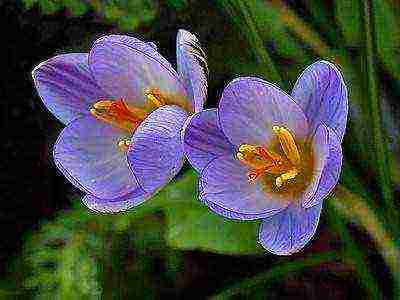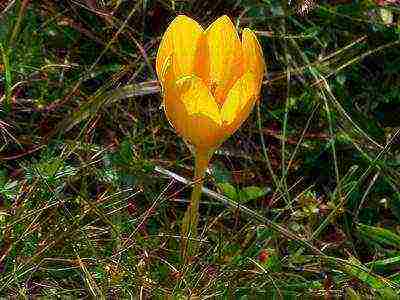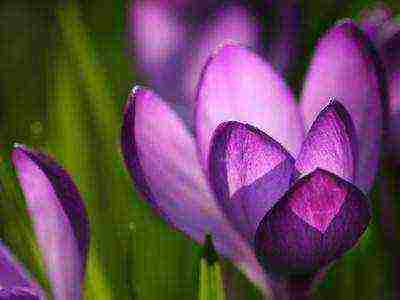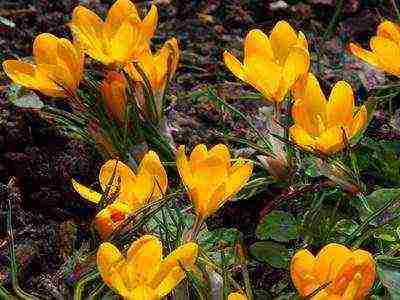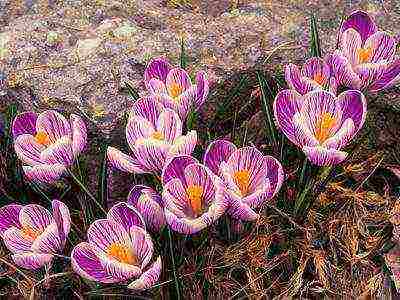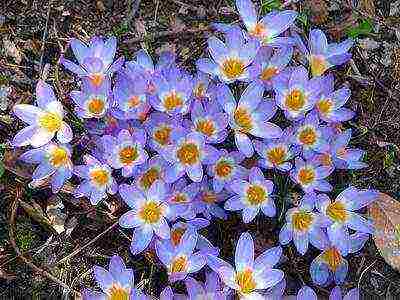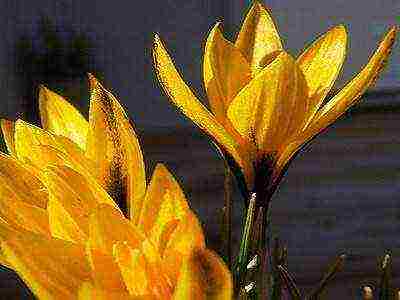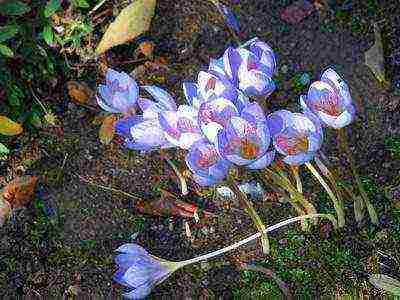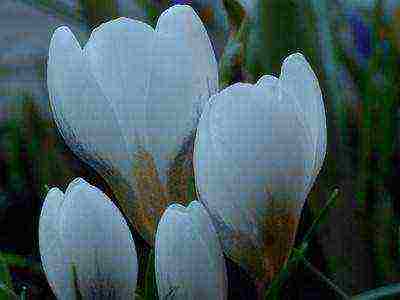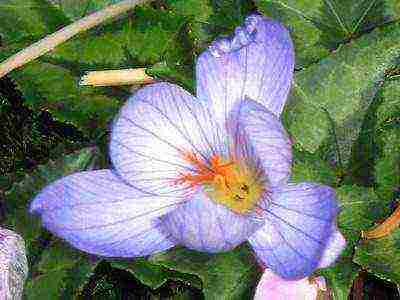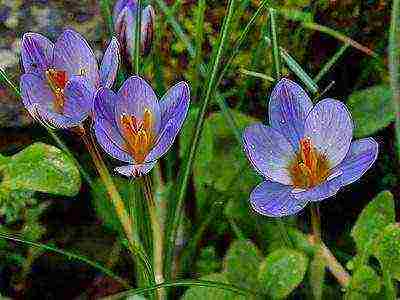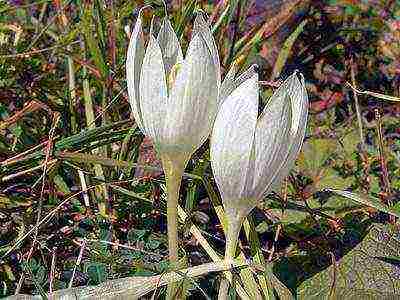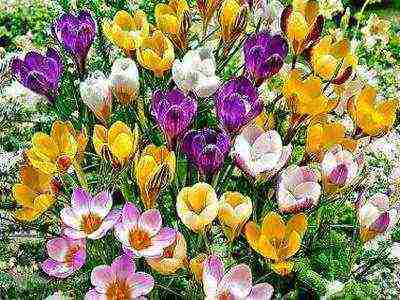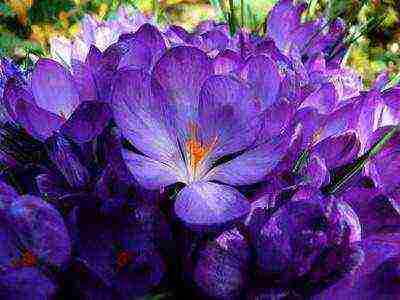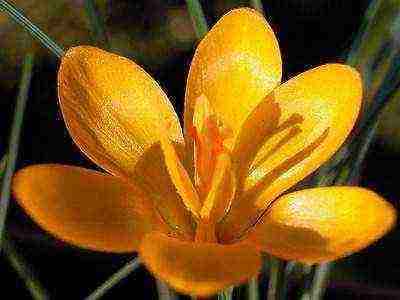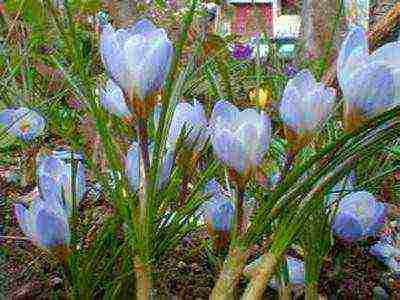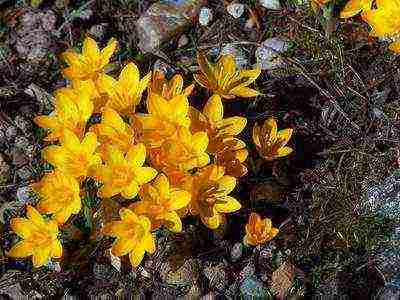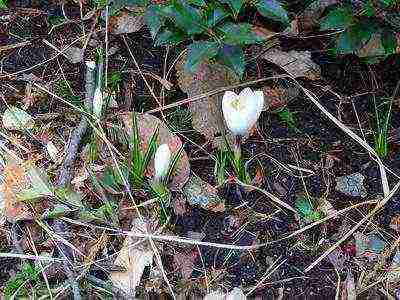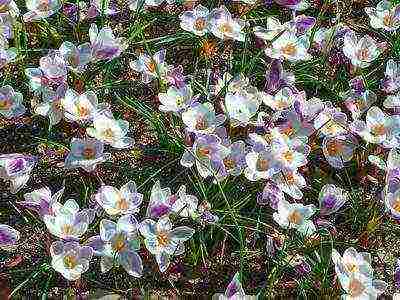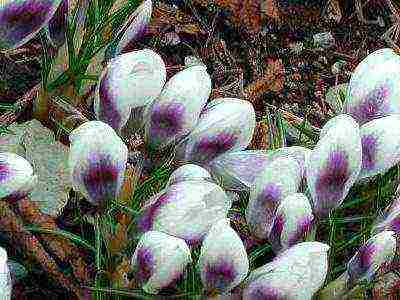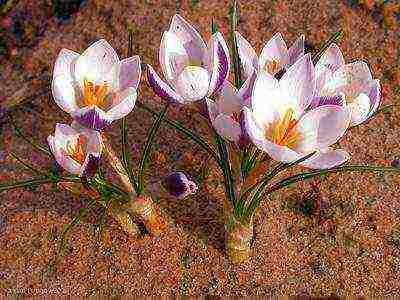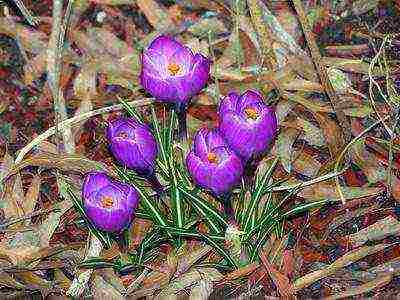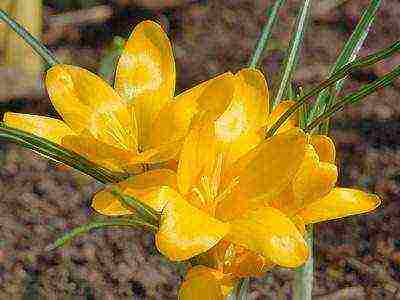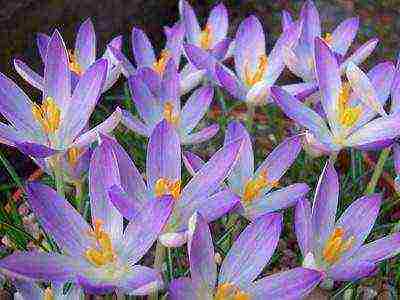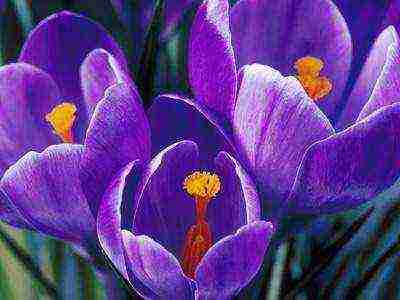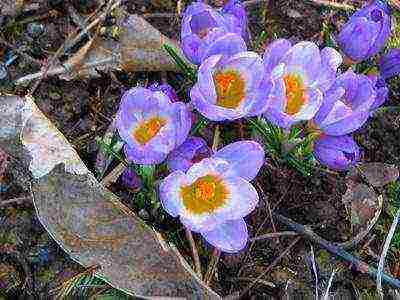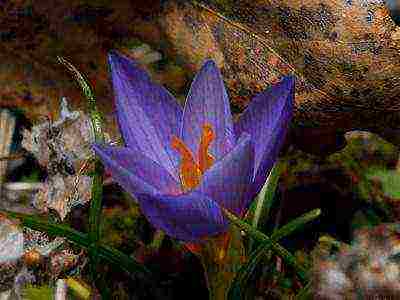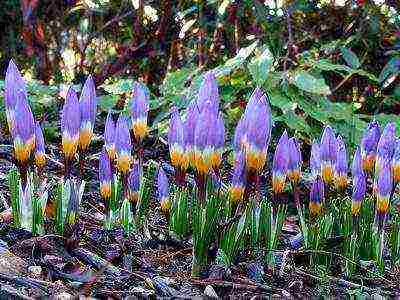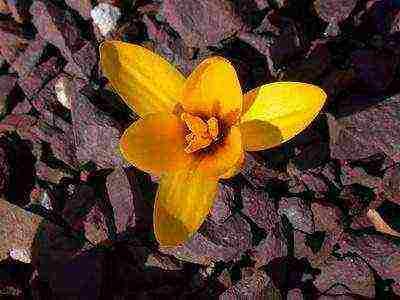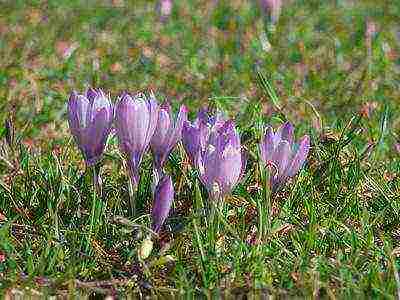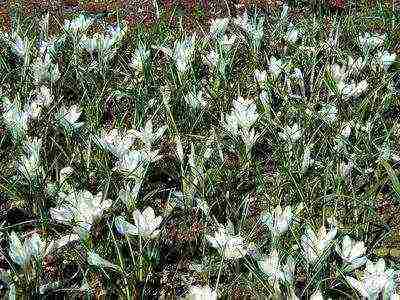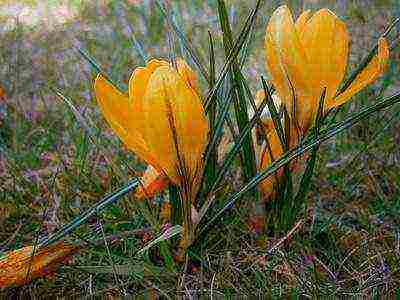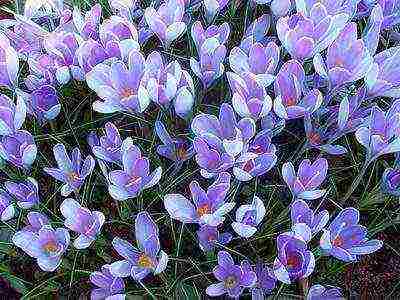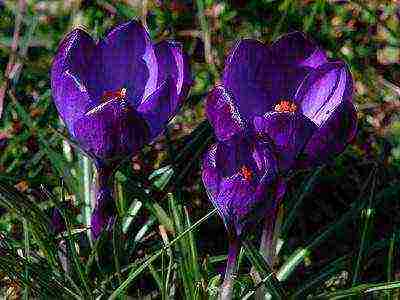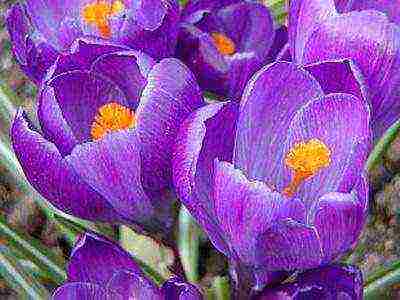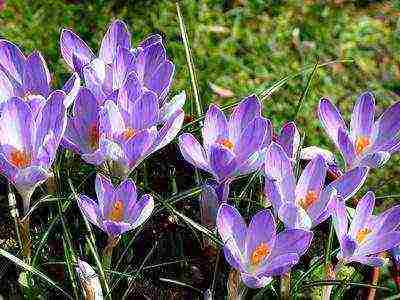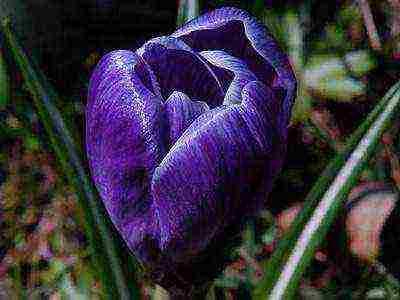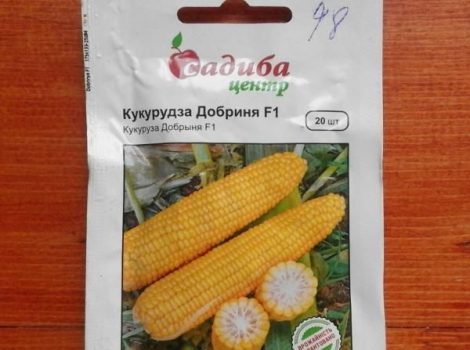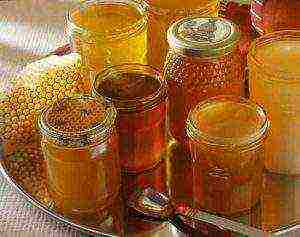Content
- 0.1 Spring blooming (April-May)
- 0.2 Autumn blooming (September-October)
- 0.3 Landing
- 0.4 Care
- 0.5 Reproduction
- 1 Crocus blue, blue and white can bloom in autumn
- 2 Crocus yellow and red more often blooms in spring
- 3 Crocus Tomasini
- 4 Crocus Zibera
- 5 Crocus Korolkova
- 6 Crocus Vanguard and Flower Record
- 7 Types and varieties of crocus
- 8 What crocuses and flower photos look like
- 9 How to grow crocus flowers
- 10 What are crocuses: description of groups and varieties
Crocus (Crocus) is the Latin name for an ornamental perennial, which has taken root along with saffron. The plant with a vibrant color palette is popular in horticulture and is grown in greenhouses and at home by forcing. In nature, crocuses have settled in the center and south of Europe, the Caucasus. Crimea, most of Asia. Some species are endangered, therefore they are listed in the Red Data Books of European countries. Stunted and medium-sized crops with narrow leaves and goblet flowers adorn the landscape of city parks and private plots in early spring and autumn.
Botanical description and distribution
The scientific name of the herbaceous, bulbous plant is saffron, from the photo it is familiar to many as a crocus. The culture belongs to the Iris or Iris family. The genus saffron has more than 80 species. The flower will sprout from a bulb up to 3 cm in diameter. It can be spherical and flattened in shape. On the outside, the bulb is covered with brown or reddish scales. A lobular root is formed in its lower part. Aboveground stem is absent, leaves are narrow, linear, rigid. From below, they are covered with vaginal scales. Green foliage may appear before or after flowering. In many species, basal leaves have a light longitudinal stripe.
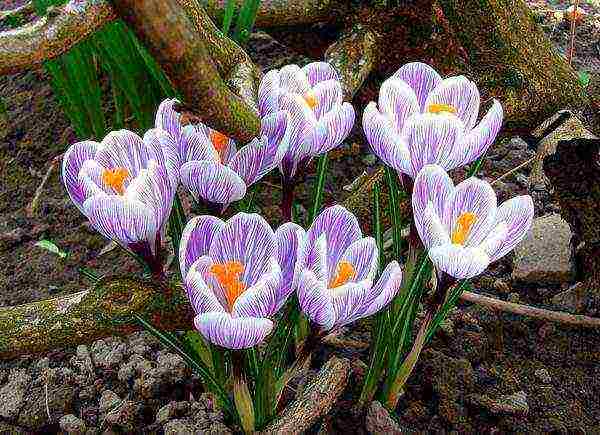 Saffron is often called crocus
Saffron is often called crocus
Information. Saffron is one of the oldest cultivated plants. It was known in Ancient Egypt for several thousand years BC. NS. Appeared in Europe in the 10th century. thanks to the Arabs. The Latin word "crocus" means thread, it is associated with elongated pistils. The Arabic name "saffron" - is translated as yellow, it is associated with the coloring ability of the flower.
Flowers one or two emerge from the corm itself. They are located on a leafless peduncle 7-25 cm long. The flower sizes in various species range from 3 to 8 cm. The bud has 6 petals, which bloom only in clear sunny weather. On a cloudy day, the buds are closed, but this does not diminish their beauty. The blossoming crocus flower looks like a bowl or a star. The stamens of the plant are attached to the pharynx of the perianth, the column (part of the pistil) has three stigmas that serve to trap pollen. Stigma is the most valuable part of the plant; when dried, it is a food coloring, medical raw material and the famous spice - saffron.
 The flower has three stigmas used as a spice
The flower has three stigmas used as a spice
Information. To collect stigmas, saffron is cultivated. The plant is sterile because it is obtained by crossing several species.
According to the color of flowers, natural species are divided into two groups: yellow-flowered (color from light yellow to orange) and blue-flowered (purple, lilac, blue). Cultivars are more varied in color, bicolor specimens have been bred. In terms of their popularity in gardening, crocuses are second only to tulips and daffodils.
Saffron - plant application
Dried stigmas of saffron have long been used as a spice with a specific aroma and bitter taste. Today, 90% of the crop is grown in Iran. The spice is used in cooking for cooking rice, peas, soups. It indicates a preservative effect, keeping the food fresh for several days.
Information. In ancient times, saffron was valued more than gold and 15 more than black pepper.And not surprisingly, to harvest 1 kg of stigmas it was required to manually process 200 thousand flowers.
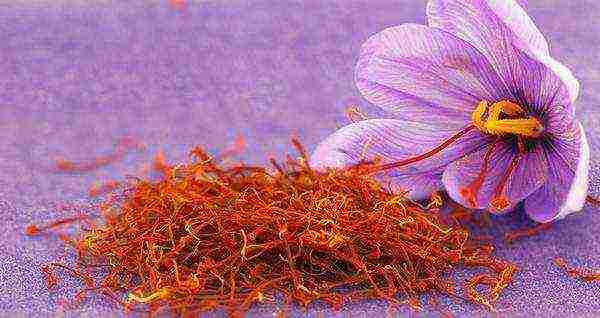 Dried saffron stigma great value
Dried saffron stigma great value
The stigma of saffron is used in medicine. Compositions based on them have an antispasmodic and stimulating effect. In folk recipes, dried stigmas are used as an analgesic and diuretic. They increase appetite. Medicinal properties are manifested due to the chemical composition of the plant. In the stigmas found:
- essential oil;
- gum;
- vitamins;
- dye crocin;
- fatty oil;
- flavonoids.
The stigmas contain a coloring agent used in the food industry. The natural compound crocin allows you to give a yellow hue to cheeses, liqueurs, dough, soft drinks.
Crocus varieties
Numerous photos of crocuses prove the importance of their decorative use in the design of gardens and home interiors. It is one of the first crops to flower outdoors in spring. All types of crocuses were divided into 15 large groups, 14 of them include plants that bloom in spring, autumn varieties are collected in one group.
Spring blooming (April-May)
In early spring, without waiting for the snow to completely melt, crocuses bloom in the garden. In the open field, they are grown in flower beds, lawns, alpine slides. Already in April, the primrose opens cupped buds on a short peduncle. Leaves may appear after flowering. They are narrow, green in color, and may have a light stripe in the middle. A month after the flower, a seed capsule appears on the surface.
Spring crocus (Crocus Vernus) is a herbaceous plant 15-17 cm high. The flower is funnel-shaped, white or purple, the anther is yellow. The mother bulb is renewed annually. 1-2 flowers grow from it. Most often, Dutch hybrids are planted in gardens. In total, about 50 varieties of the crop have been registered. According to their color, they are divided into three groups: white, mesh and monochromatic (lilac, purple and others). Flowering lasts a little over two weeks.
 Spring crocus
Spring crocus
Common varieties include:
- "Remeberance" - large flowers with a diameter of more than 5 cm of a violet shade with a silvery sheen;
- "Pickwick" - rounded petals, light lilac with gray veins;
- "Snowstore" - rounded flowers with a diameter of 5 cm, snow-white with purple stripes at the base;
- "Nigro Boy" - a dark purple flower with a purple base, differs in late blooming - in May.
Golden-flowered crocus (Crocus chrysanthus) - height up to 20 cm.The leaves are narrow, appear in early April, along with yellow flowers. The bulb is spherical, slightly flattened. The perianth lobes are bent outward.
 Crocus golden-flowered
Crocus golden-flowered
There are varieties:
- Snowbunting - with white petals and golden center;
- Blue pearl - blue with yellow bases
- Lady killer - purple on the outside and white on the inside
- Blue Bonnet 0 blue petals with a yellow spot in the throat.
Crocus heuffelianus is named after the Hungarian botanist J. Heuffel. This species is common in the Carpathians. Plant height 10-19 cm, round corm. Leaves are linear with curled edges. There is a silvery stripe in the center. The petals are purple, less often white. On the outside, they are darker. The flowering period is 25 days.
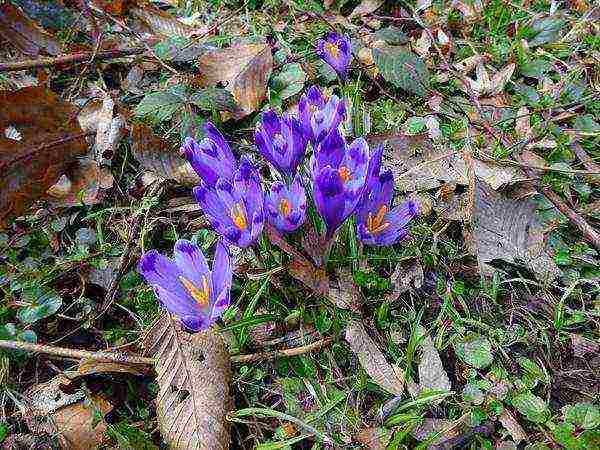 Crocus Geyfel
Crocus Geyfel
Net saffron (Crocus reticulatus) is a rare species listed in the Red Book. Found in Central and Eastern Europe, Crimea, Transcaucasia. Height 15 cm, spherical bulb. Leaves after flowering elongate significantly. The color is white or purple, with purple stripes on the outside of the petals.
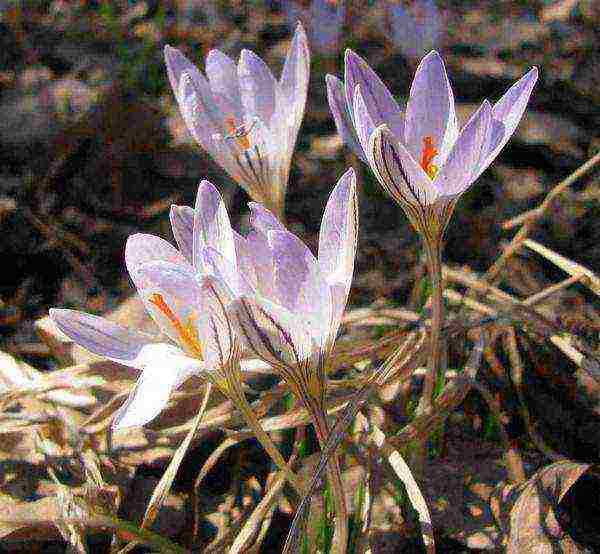 Net saffron
Net saffron
Saffron Tomasini (Crocus tomasinianus) - belongs to the earliest spring varieties. The plant is unpretentious, feels great in shaded areas. Crocus height 7-8 cm, flower diameter 2-4 cm, this is one of the smallest species. The color of the petals is lilac, purple, white. Grows easily in all conditions, often found in parks.
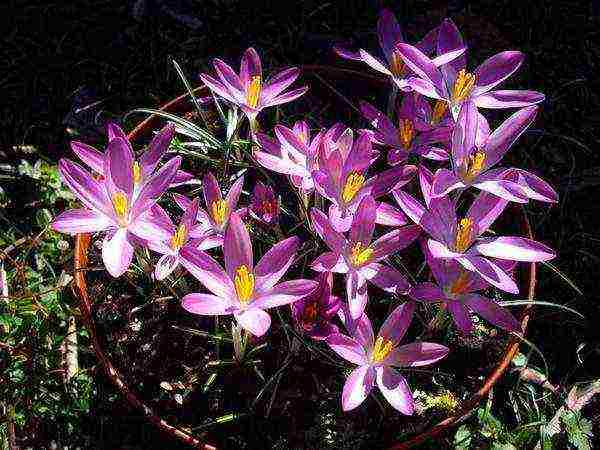 Saffron tomasini
Saffron tomasini
Varieties:
- "Lilac Beauty" - purple petals;
- "Ruby giant" - large, star-shaped flowers have a purple-violet color;
- Roseus - pale pink and white petals.
Autumn blooming (September-October)
A large group of ornamental saffron blooms in the fall, like the last chord of a withering garden. Autumn crocuses are low and compact; they are used in border plantings along the paths. Bright flowers look great at the foot of trees and shrubs. Saffron, which blooms in September, adorns the rocky alpine hills. Often the culture is grown in pots and flowerpots. Picturesque groups of flowers decorate the entrance area, window sills, terrace. Among the autumn species:
The beautiful crocus (Crocus speciosus) is one of the largest autumn saffron. Its leaves reach 30 cm, the diameter of the flowers is 7-8 cm. The color is lilac, purple with dark veins. The petals are symmetrical with pointed tips. Flowering continues for a month. The number of leaves is 2-4, the length is up to 40 cm. The stigmas contain a coloring matter.
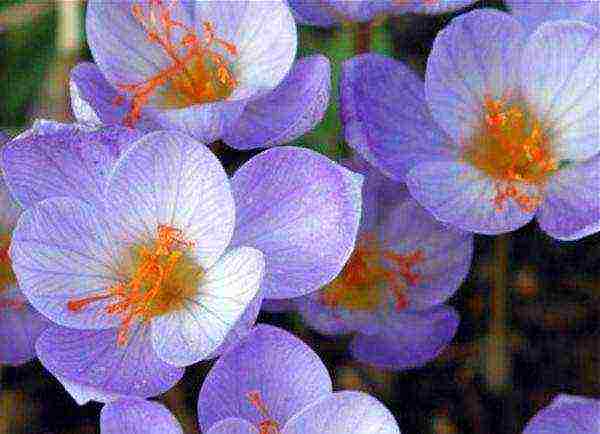 The type of flower fully justifies its name.
The type of flower fully justifies its name.
Garden forms:
- Albrus - white petals;
- Artabir is a variety with blue buds and purple veins;
- Oxinan - differs with pointed petals, slightly bent back, color - purple.
Sowing saffron (Crocus sativus) - the plant does not occur in the wild and reproduces with the help of humans. It is cultivated for the stigmas used as a popular spice. The height of the herbaceous plant is 12-30 cm. The bulb is spherical with fibrous roots. Fragrant large flowers are available in white, purple and yellow. They consist of 6 folding petals. The stigmas are long, red, hanging down between the petals.
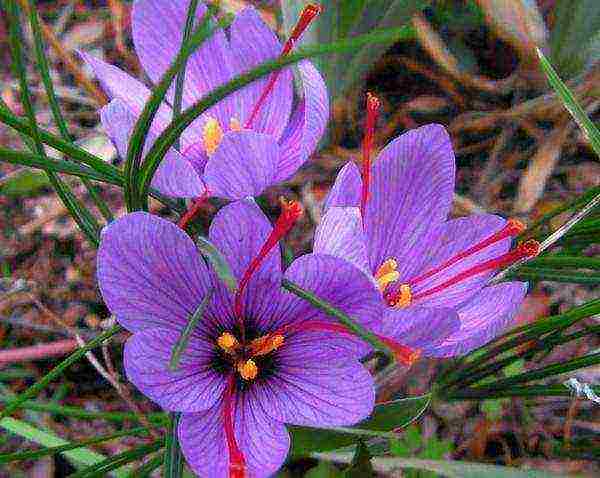 This species cannot be found in the wild.
This species cannot be found in the wild.
Pallas' saffron (Crocus pallasii) - The narrow green leaves emerge from the ground in April and bloom only in September. Spectacular buds up to 5 cm in diameter, light purple color with purple veins. The stigmas are yellow. In nature, it grows in the Transcaucasus.
 Pallas' saffron
Pallas' saffron
Crocus hill or valley (Crocuse vallicola) is a miniature plant 6-12 cm.It grows in Asia Minor and the Caucasus in mountain meadows. The corm is flat, covered with a fibrous sheath. Leaves appear in spring and dry up by summer. Petals are white, stigmas are short, orange.
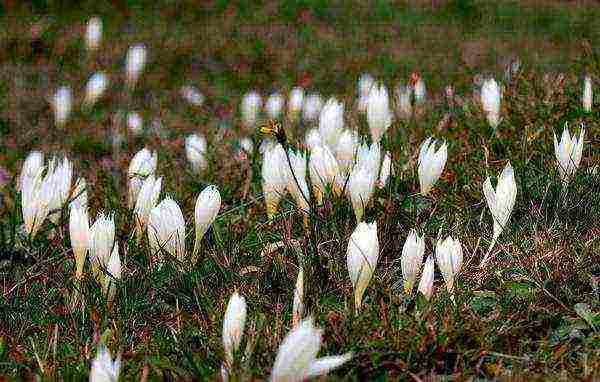 Knoll crocus
Knoll crocus
Banat crocus (Crocus banaticus) is a large species that grows in deciduous forests and meadows of Eastern Europe. Height 15-30 cm, thin leaves, flowers - lavender or purple. Each bulb produces up to two flowers. The three inner petals are significantly smaller than the three outer ones. The plant was first described in 1831 by the French scientist J. E. Ge. Crocus is listed in the Red Book in Serbia and Ukraine.
 Crocus Banat
Crocus Banat
Regardless of the flowering time, decorative saffron is grown according to the same technology. A sunny place with loose, drained soil is chosen for it. The soil should be fertile, neutral, structured with an admixture of sand. You can improve the composition of the soil by introducing compost and humus before planting. Per sq. m will require 15 kg of compost and 100 g of superphosphates, providing abundant flowering. Plants overwinter in the ground.
Attention. In one place, saffron is grown for 4-6 years.
Landing
Crocus or saffron blooming in spring is planted in autumn and autumn varieties are planted in late summer. Before planting, the bulbs are examined, choosing only healthy material. Autumn flowers are planted in groups of 5, at a distance of 5-6 cm from each other. In light soil, they are buried to a depth of twice the growth of the bulb. After a few years, each bulb produces many babies, the flowers form a solid carpet, but due to the tightness, the size of the buds decreases. Plants are recommended to be planted in other areas.
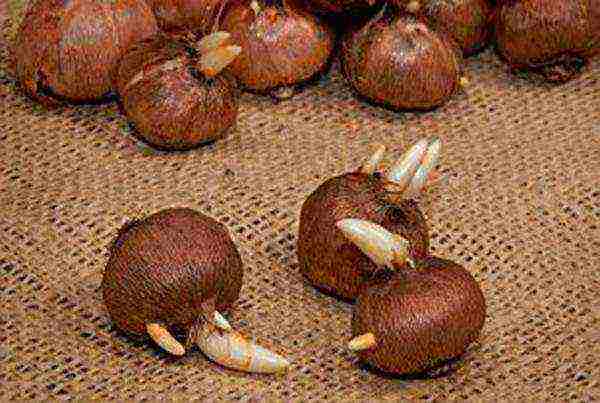 Saffron - corm plant
Saffron - corm plant
Care
Saffron requires a minimum of maintenance: watering, loosening the soil and weeding. Often there is no need to moisturize the flowers; the weather conditions must be taken into account. Excess moisture is a fertile environment for fungal infections.After flowering, wilted leaves and flowers are cut off, the bulbs are left in the ground or dug out for drying and sorting.
Reproduction
The best breeding method for crocuses is with daughter bulbs. They are dug up and dried for 2-3 months in a well-ventilated area at room temperature. Then it is cleaned of old roots and exfoliated scales. The spoiled copies are immediately thrown away. Saffron can be propagated by seed, but this method does not always preserve varietal characteristics and postpones flowering time by 2-3 years. Autumn crocus is a plant that does not always have time to give a ripe box with seeds before the onset of cold weather.
 Over time, crocuses grow into large families.
Over time, crocuses grow into large families.
The saffron flower is insect-pollinated or self-pollinated. Its fruit grows and ripens underground, and is thrown to the surface already formed, ready for disclosure. Seeds of spring-flowering varieties are planted in the fall in the ground or in the spring in containers for seedlings.
Crocus cultivation does not create difficulties and problems with care, and bright blooming will be a wonderful accent of the garden.
Moscow, Russia, on the site since 11.01.2017
The genus of crocuses or saffron is quite numerous, includes about 80 species, about half of them are used in decorative floriculture. In the gardens, both natural forms and varieties and hybrids created by breeders are grown. The classification of natural species is quite complex and has changed several times over the past 200 years. Currently, it is customary to divide the genus into two subgenera, Crocus and Crociris, based on the structure of the bulb and the presence or absence of a wrapper at the base of the flower arrow.
The subgenus Crociris includes a single species crocus banatsky (C. banaticus), 10-14 cm tall, with funnel-shaped perianths ranging in color from light purple to dark purple. This flower, which blooms in September, grows wild in Romania, is considered rare, but the easiest to cultivate, it has an unusual shape, reminiscent of irises. Its inner rounded segments are two times shorter than the pointed outer ones; the yellow anthers contrast effectively with the dissected pale purple stigmas.
The subgenus Crocus includes all other species, which are conventionally divided into 15 groups or series, differing in the structure of the corms' shells. Not all of them are of interest for decorative floriculture, some consist of one or 2-3 rather rare wild-growing varieties that are not used in culture.
In the gardens, mainly plants belonging to the groups are grown:
crocus (crocus) (because sowing and Pallas);
Kochi (kotchschyani) (K. Sharoyan and valley);
return (verni) (because spring and Tomasini);
biflori (biflori) (because golden and two-flowered);
specialsi (speciosi) (because fine);
flavi (yellow);
reticulati (Reticulati) (K. Sieber);
orientales (K. Korolkova).
By the time of flowering, spring and autumn crocuses are distinguished, and since usually yellow and blue petals do not occur simultaneously within natural species, they are divided into yellow-flowered and blue-flowered by color. The exception is golden crocus, perhaps in this case the blue-flowered forms are of hybrid origin. White specimens are less common in nature, more often found in blue-flowered species.
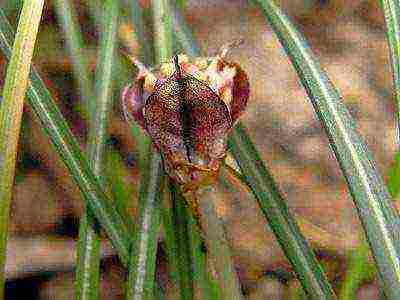
Crocus flower in the photo
Crocus varieties are very numerous, currently there are about 300 registered in the world. Below are descriptions and photos of crocus species most often used in culture, as well as the most popular varieties and hybrids recommended for cultivation in our country.
Crocus blue, blue and white can bloom in autumn

Blue crocus flower in the photo
They bloom in September-October, are found in our gardens less often than spring ones, meanwhile they are less demanding on lighting, resistant to diseases and very decorative. In central Russia, it is recommended to grow:
Crocus beautiful (C.speciosus), the most popular and most large-flowered species, with blue-violet, decorated with darker or purple veins, fragrant flowers up to 12 cm in diameter.They bloom in September on leafless peduncles reaching 12-18 cm, and bloom for a month. Leaves, 20-30 cm long, 0.6-1.3 cm wide, emerge from the ground in spring and die off by early July. In nature, the plant is found in the Balkans, in Asia Minor, as well as in the Crimea and the Caucasus.
There are many garden forms of various colors, among which are:
blue crocus cassiope
lilac Artabir
white albus
light purple Pallux.
Sowing crocus (C. sativus), is cultivated in the world on an industrial scale, it is its flowers that are used as a spice "saffron". The plant is 10-30 cm high with narrow, only a few millimeters wide, erect leaves, covered with cilia and curved at the ends. Light purple or white flowers bloom on shortened flower arrows, have a 6-petal corolla and a tube 10-15 mm long, and have a pleasant violet scent. Unlike the previous species, leaves appear with flowers or immediately after them, mass flowering lasts one to two weeks, and each individual flower lives for about three days. India is considered the homeland of the species, however, the currently cultivated plant is a hybrid, the result of natural crossing of several ancient varieties of culture.
Crocus Pallas (C. pallasii), less common in gardens, undersized, no higher than 5-6 cm, with single pale purple flowers with a pink tinge, having a purple base, the same vein color and strongly curved edges of the perianth. Corolla diameter up to 4.5 cm. It opens in September and blooms for 30 days, narrow-linear leaves about 20 cm long appear in April. It grows wild in Asia Minor, in the Balkans, in the territory of the former USSR - in the Crimea.
Even less often in gardens you can find bright orange blossoming at the end of summer crocus Sharoyan (C. scharojanii), Caucasian species with bare leaves up to 20 cm long, up to 1.3 cm wide, sometimes persisting until the next flowering.
AND white crocus valley (C. vallicola), flowering in August or early September. In the latter, leaves appear in early April, and completely dry out in early June.
Crocus yellow and red more often blooms in spring
They bloom in spring, from early April to May, and in countries with warmer climates at the end of winter (February).
There are two groups:
botanical crocuses (C. botanical), including small-flowered natural forms and varieties.
and large-flowered (C. largeflowering), Dutch hybrids derived from spring crocus.
Of the botanical species in the gardens of the middle lane are grown:
Crocus golden (C. chrysanthus), up to 20 cm high, with narrow leaves that appear with flowers that bloom in April and bloom for about 15-20 days. The natural appearance is golden yellow, with glossy outside and curved perianth lobes, often in the outer part of the base with darker stripes and strokes. There are many differently colored varieties, including hybrid ones, obtained with the participation of other species, in particular, two-flowered crocus.
The hybrids of the Chrysanthus group, in contrast to the Dutch ones, are smaller in size, bloom earlier, and differ in many flowers - several buds appear from one bulb at the same time.
Popular varieties:
Blue pearl
Princesses Biatrix, blue with a yellow base
white white triumphant
creamy beauty cream
light yellow Mammut
purple with golden throat Violet Queen.
There are a number of shapes that have contrasting petals with stripes and various strokes:
Nanette, with large creamy flowers decorated with purple markings on the outside.
Lady Keeler, inside is snow-white, outside is purple-purple with light streaks, etc.
Below are a few more photos of crocus varieties from the Chrysanthus group:
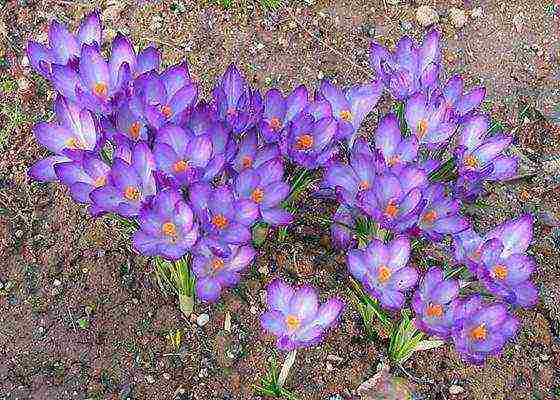
Crocus Ruby Giant in the photo

Crocus Zwanenburg Bronze pictured
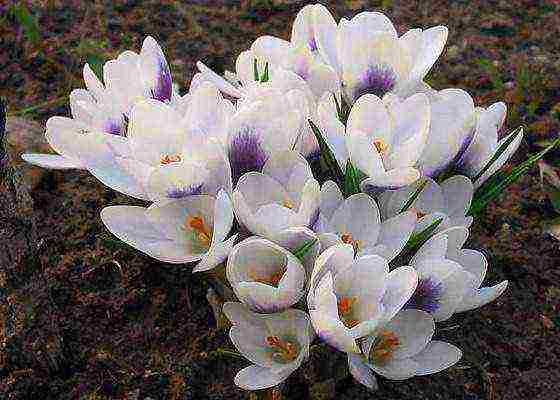
Crocus Prince Clause pictured
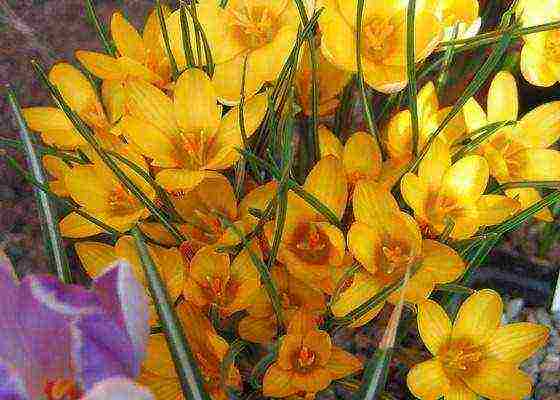
Crocus Princess Beatrix pictured
Crocus two-flowered or Scottish (C. biflorus), naturally grows in the south and south-west of Europe, Asia Minor and the Caucasus. In a natural species, red or purple petals and yellow stigmas are unusual for crocuses.
There are variegated varieties:
Alexandri, very decorative, dark purple outside with narrow white piping, snow white inside.
Parkinsonias, with the outer petals of a straw-yellow color, the inner ones - white with small blue blotches, from the inside snow-white with an orange center.
There are solid color cultivars, for example:
pure white Albus
faerie bluish tint.
Crocus yellow (C. flavus Weston), a plant native to the mountainous regions of the Balkans and Asia Minor, grows up to 20 cm, has linear, ciliate leaves about 10 cm long and short (5-8 cm) peduncles with large golden-orange flowers. The perianth diameter reaches 7 cm, and the tube length is 8 cm. It blooms for 20 days in early spring (April).
The well-known Largest Yellow variety is distinguished by even larger than the natural species, flat dark yellow cupped flowers, decorated with dark stripes on the outside.
Crocus Tomasini
Crocus Tomasini or Neapolitan (C. tomasinianus) - one of the most unpretentious spring primroses, found in the wild in the Balkans, Bulgaria, Hungary. It adapts well to any conditions, can grow in relatively shaded places without much maintenance. Blossoms in early April, natural forms have perianths of pink-lilac tones, 3-5 cm in diameter, with a whitish core.
In decorative floriculture, the following varieties are common:
Ruby Giant, a deep purple-red crocus with large flowers.
Lilac Lilac Beauty
Whitewell Purple, deep purple with a mauve heart.
Crocus Zibera
Crocus Zibera (C. sieberi), rare enough for our gardens and at the same time one of the most beautiful ornamental species. The plant is native to the mountainous regions of Greece, Bulgaria, Macedonia, 8-10 cm high, has an original tricolor color. In natural specimens, the petals can vary from light pink to deep purple, the center is usually yellow with bright orange pistils.
Garden forms are especially attractive:
Bovlezis White, pure white with a bright orange throat;
Atticus, a bright blue crocus with a yellow-orange heart;
Tricolor, cultivar with dark purple petals on top, lighter ones below, and bright yellow throat.
Crocus Korolkova
Crocus Korolkova (C. korolkowii Maw ex Regel), low, up to 6 cm, Central Asian species with bright orange flowers, outside covered with red stripes, there are varieties of Russian selection, in particular, Spring Kiss, Slava Samarkand, Tiger.
Spring crocus (C. vernus), the most widespread spring-flowering species in the culture, growing naturally in high-altitude meadows in the Pyrenees and the Alps. In nature, it has single lilac or purple flowers up to 5 cm in diameter. This variety served as material for the creation of numerous hybrid varieties widely grown around the world, which are usually distinguished into a separate group of large-flowered crocuses or Dutch hybrids.
Crocus Vanguard and Flower Record
The varieties that belong to the group of large-flowered Dutch hybrids are unpretentious, are distinguished by especially large flower sizes, on average, exceeding natural species by 2 times and their goblet shape. Plant height reaches 15 cm, thin long leaves appear after flowers, bulbs are covered with brown fibrous skin.
The first cultivar was created in 1897, since then there has been constant work on the creation of new hybrids, with the participation of both spring and yellow crocus.There are more than 50 varieties with flowers of various sizes and colors, both monochromatic and variegated. Among them there are white, yellow, lilac, blue, purple, purple-red crocuses.
Photos and descriptions of some of the most common varieties in our country are presented below:
Joan of Arc (Joan Of Arc), white, with large (up to 5 cm) flowers growing 3-5 pcs. from one onion.
Yellow Mammoth (Yellow Mammoth), yellow-flowered, 10-15 cm high;
Wangart (Vanguard), a light bluish-lilac crocus, 10-15 cm high, up to 4.5 cm in diameter.
Nigro Fight (Negro Boy), a hybrid with goblet perianths measuring 4-5 cm, deep lilac-lilac shade with a dark lilac base.
Flower Record (Flower Record), a purple-purple crocus, excellent for forcing.
Remembrans (Remembrance), with deep purple, goblet-shaped flowers pointing upwards.
All Dutch varieties bloom for a long time, up to 20 days, while significantly differing in the timing of the beginning of flowering.
The earliest, for example:
crocus Vangart, bloom in April;
late (Nigro Boy) - at the end of May, which allows you to have flowering specimens in the garden from early spring to early summer.
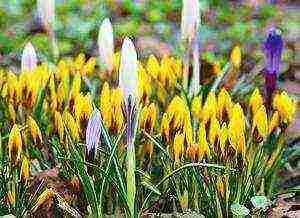
One of the earliest flowers to bloom in spring is Crocus, or saffron. It belongs to the Iridaceae family. It is a genus of perennial corms native to Europe, North Africa and western Asia.
Natural growing conditions explain their "love" for rocky, sandy, loose soils and sunny areas. Dr. David Hession in his book "All About Bulbous Plants" named the crocus one of the representatives of the "magnificent four" along with tulip, daffodil and hyacinth.
Crocus is a monocotyledonous plant; its narrow, elongated leaves with a lighter stripe in the middle resemble the leaves of cereals. The flower consists of six oval-shaped perianth lobes.
Nutrients are stored in the corms, and after flowering and drying of the leaves, 1-3 replacing corms and small daughter corms are formed. The peduncle appears on the surface of the earth earlier or simultaneously with the leaves.
The genus Crocus has about 80 species, of which not all bloom in spring. For example, the beautiful crocus (C. speciosus), the Pallas crocus (C. pallasii), and the mound crocus (C. vallicola) bloom in September. Although dormancy in the summer months is a common property of all species.
The fields of application of this plant are very diverse. It is a colorant, a seasoning, and a medicine, and in the modern world it is a valuable forcing and pot culture, as well as an indispensable component for landscaping.
In the 16th century, the common crocus (C. sativus) appeared in Europe, although interest in it as an ornamental plant arose later, with the entry into European gardens of three more species: narrow-leaved crocus (C. angustifolius), yellow crocus (C. flavus) and spring crocus (C. vernus). It is to these species that we owe the appearance of groups of Dutch hybrids (or large-flowered) and a group of Chrysanthus varieties.
The first crocus variety was registered in 1897, now there are more than 200 of them. You will certainly be delighted not only by a wide range of colors, both uniform and monochromatic, as well as mesh or striped, but also a variety of varieties - for the most demanding taste.
The varieties also differ in large stamens and pistils of yellow or orange color of varying degrees of saturation.
Types and varieties of crocus
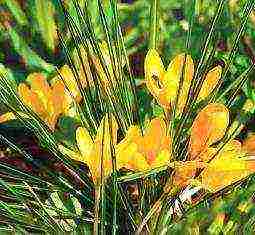 Saturnus
Saturnus
Golden crocus (C. chrysanthus)
A beautiful variety with wide-open flat flowers, about 3.5 cm in diameter, with oval lobes. The color is creamy yellow with a dark yellow throat. Outside, at the base of the lobes, there is a small brownish-green spot, and on the lobes of the outer circle there are thick lilac streaks.
The pistil is slightly longer than the stamens, the anthers are light yellow, sterile, the stigmas of the pistil are orange-red. Average flowering time.
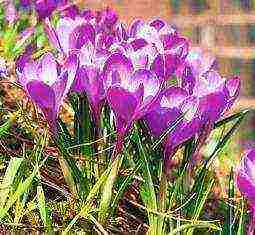 Grand maitre
Grand maitre
Spring crocus (C. vernus)
A variety with large, beautiful goblet flowers about 4 cm in diameter, with oval lobes. The color of the lobes is deep purple, outside at the base there is a large dark purple spot. The tops of the lobes of the outer circle are slightly pointed.
The tube is dark purple, up to 6 cm long. The pistil and stamens are large enough, located at the same height. Anthers are bright yellow. Flowering at a later date.
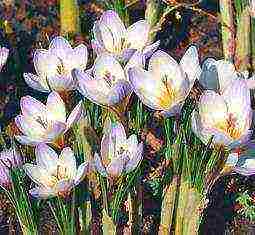 Blue Pearl
Blue Pearl
Golden crocus (C. chrysanthus)
The flowers are cup-shaped, medium-sized, about 2 cm in diameter. The variety is distinguished by the presence of aroma. The color of the lobes is white with a pale blue tint. The color of the base is deep yellow. Outside, on the lobes, there may be rare blue-violet strokes of varying saturation.
The pistil is large, located above the stamens, anthers are cream-colored. The variety is characterized by early flowering.
 Pickwick
Pickwick
Spring crocus (C. vernus)
Leaves appear before flowers. The flowers are very large, 4 cm high and 5-6 cm in diameter. Their shape is goblet. The color of the lobes is heterogeneous, the lobes are white with a delicate purple tint, have dark purple, almost violet stripes (strokes).
At the base, spots of a saturated dark purple color are visible. The stamens are large, bright yellow. Flowering takes place at a later date.
 Mammoth Yellow
Mammoth Yellow
Spring crocus (C. vernus)
A characteristic feature of this variety is that it is the largest of the yellow crocuses. The diameter of the flower is 2.5 cm, and its height can be up to 3.5 cm. The flowers are wide open, flat in shape.
The color of the lobes is light yellow, under the rays of the spring sun it becomes richly golden. The base of the lobes is darker. The flowering of this variety takes place at a later date.
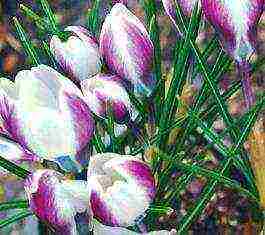 Lady Killer
Lady Killer
Golden crocus (C. chrysanthus)
The flower is of medium size, 3.5 cm high, up to 3 cm in diameter. The shape of the flower is cupped, almost flat. The inner lobes are pure white, the outer ones are lavender with a white border around the edge. There are small gray-blue spots at the base.
Anthers are yellow, sterile. The pistil rises above the stamens. Flowering takes place early. The variety has a light pleasant aroma.
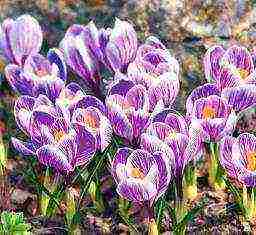 King of Striped
King of Striped
Spring crocus (C. vernus)
Leaves appear before flowers. Flowers 3, 5-4 cm high, reach about 4 cm in diameter, goblet, with almost rounded lobes. Their color is net. The outer lobes are white-lilac, the inner ones have lilac stripes.
At the base of the lobes there is a large, clearly visible light purple spot. Anthers and stigmas are bright yellow. Flowering at a later date.
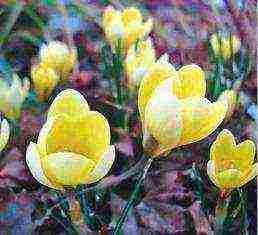 Romance
Romance
Golden crocus (C. chrysanthus)
The flowers are cupped, almost flat, small, about 3 cm in diameter, with oval lobes. The color of the lobes is delicate, creamy yellow, the outer lobes are of a pleasant cream color. There is a small spot outside at the base of the lobes.
The tube is grayish cream, about 3 cm long. The pistil is longer than the stamens. Anthers cream. Leaves with a central white stripe along the entire length. Medium flowering variety.
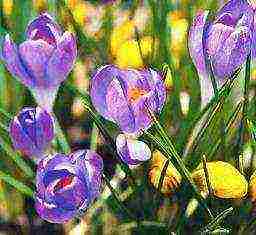 Purpureus Grandiflorus
Purpureus Grandiflorus
Spring crocus (C. vernus)
Leaves appear before flowers. The flowers are large, goblet, and can reach 5 cm in diameter. The color of the perianth lobes is bright purple, slightly darkening at the ends. At the base of the outer lobes, it can be seen by a large blurry dark spot.
Large bright yellow fringed stigmas of the pistil protrude significantly above the bright yellow stamens. Flowering occurs at a later date.
 Snow Bunting
Snow Bunting
Golden crocus (C. chrysanthus)
The variety was bred in 1926. The flowers are of medium size and have a noticeable aroma. The predominant color of the lobes is white. The coloration of the base of the inner lobes is bronze-yellow. Large dark bronze stripes are visible from the outside.
The pistil is massive, towering over medium-sized yellow stamens. The variety is very effective with full disclosure of flowers in the bright sun. Blooms early.
 Flower record
Flower record
Spring crocus (C. vernus)
In this variety, leaves appear before flowers. Flowers are goblet-shaped, large, up to 4.5 cm in diameter, tube up to 4.5 cm long. The oval lobes have pointed tops. The color of the lobes is dark purple with a purple tint.
At the base, the lobes have a small blurry purple spot. The bright yellow stigmas of the pistil are located above the yellow stamens. Flowering at a later date.
 Gipsy Girl
Gipsy Girl
Golden crocus (C. chrysanthus)
The plant is 7-10 cm high.The shape of the flower is cupped, wide opening. The flower is medium, up to 3.5 cm in diameter. The color of the inner lobes is light yellow with a dark yellow base; the outer lobes are lighter, creamy yellow with clear, wide, dark purple, brownish strokes.
The dark red stigmas of the pistil rise above the dark yellow stamens. The variety is distinguished by its early flowering.
Crocuses in landscape design
Crocuses bloom in late April - early May. They are cold-resistant, withstand frosts down to - 5 - 7 ° С. The flowering period is 10-15 days. To increase the flowering period, it is recommended to select varieties of different periods: early, medium, late.
Once every 4 - 5 years, the curtains are seated for rejuvenation, an annual transplant is not required. Corms are planted in September at a distance of at least 7 cm from each other.
There are many species of crocuses on sale now. When buying such corms, it should be borne in mind that the diameter of the flower will be smaller, the colors will not amaze with variety, and earlier flowering can lead to the death of the plant due to inconsistency with the natural or weather conditions of the region.
However, the undoubted advantages of species crocuses are relative unpretentiousness and early flowering (under favorable conditions), they will also be of interest to collectors.
Crocuses and other early flowering bulbs are indispensable for creating spring color in the garden. They look good in group plantings with botanical tulips, undersized daffodils, hyacinths, muscari, galanthus, scylla, primroses.
Beautiful combinations form clumps of crocuses against the background of perennial ground cover species or a growing lawn. When growing on a lawn, it should be remembered that crocus leaves cannot be removed until they are completely dry, this will affect the mowing of the lawn.
Groups consisting only of crocuses of nuanced or contrasting colors, which are later replaced by annual flowers, look good. Crocuses are often used for planting in gravel gardens, rockeries and rock gardens.
These plants are for open field, but they are also used for forcing and as a pot culture. If you have blooming crocuses on your window, and you want to extend their life by planting in the ground, you should follow simple recommendations.
The simplest thing is if the plant has blossomed in spring. Then a green, possibly still blooming crocus with an earthy clod can be transferred to the soil at the end of May - June. If the flowering plant was acquired earlier, then after flowering, watering should be gradually reduced, and after the leaves turn yellow, watering is extremely rare.
The pot with a dried stem must be transferred to a dry, dark place until September. Such a corm can be planted in the ground without a clod of earth. In both cases, flowering should be expected no earlier than a season later - due to the strong depletion of the corm. They are unsuitable for re-forcing.
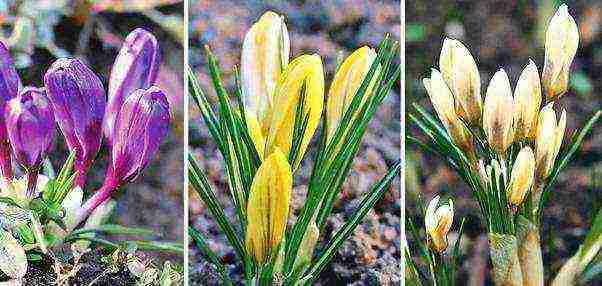
Ksenia Kruglova
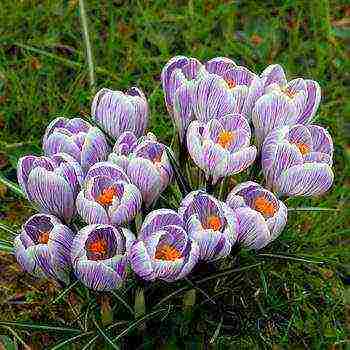 Perennial plants crocuses delight gardeners at the same time as snowdrops - they are one of the first to appear on islands of land freed from snow, and bloom for about a month. All species diversity of crocuses is divided into 15 large groups. The first of them is given to the autumn varieties. All the other 14 groups of crocuses are spring flowers with narrow-linear leaves and petals of various shades.
Perennial plants crocuses delight gardeners at the same time as snowdrops - they are one of the first to appear on islands of land freed from snow, and bloom for about a month. All species diversity of crocuses is divided into 15 large groups. The first of them is given to the autumn varieties. All the other 14 groups of crocuses are spring flowers with narrow-linear leaves and petals of various shades.
What crocuses and flower photos look like
Crocuses (saffron) are the earliest flowering of the Kasatikov family. The crocus genus has about 20 species. Wild crocuses can be found in alpine meadows, in the mountains, on the rocky talus of the Crimea, the Caucasus, Central Asia, the Mediterranean and in central Europe. Most crocuses bloom in spring, but there are also autumn-blooming species.
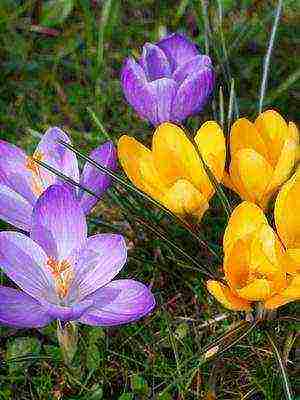
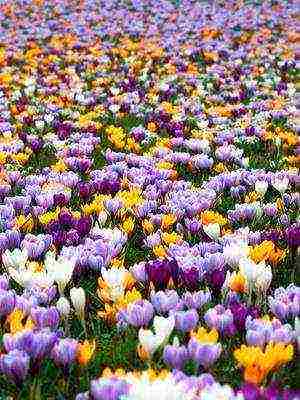
Multi-colored crocuses, appearing on snowy thawed patches along with snowdrops and scyllas, bring spring to the garden and tell us - the end of winter, it's time to move to the garden.And although many gardeners choose to live in the city, the blooming of the crocuses marks the beginning of the summer cottage season.
What do crocuses look like and what distinguishes flowers of all kinds?
A characteristic feature of crocuses is the absence of an aerial stem. The inflorescences are rather large, directed upwards. According to the description, crocus flowers at the time of blooming resemble glasses or funnels, each has six petals, they come directly from the corm. Blooming flowers can be star-shaped or cupped.
Look at the photo of what crocuses look like - the color of the flowers of these plants is very diverse:


There are flowers with white, purple, lilac, purple, yellow, orange, pink petals. There are no only pure reds.
In the center of each flower, a bright orange pistil is sure to glow. Leaves are narrowly linear, usually with a longitudinal white stripe. In spring crocuses, leaves appear during or after flowering, the seed capsule emerges on the surface of the ground a month after flowering.
Here you can see photos of crocus flowers of various types:

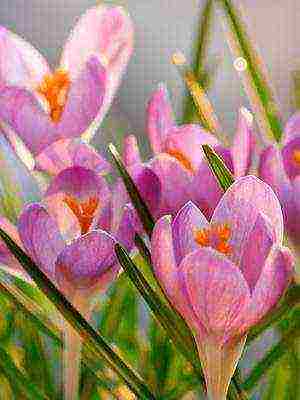
How to grow crocus flowers
How to grow crocuses on your garden plot? It is preferable to choose a sunny place for planting, although the plants tolerate shading in the afternoon. Another important condition for planting crocuses is loose, drained soil. Sandy loam soil with a neutral reaction is optimal. Plants cannot tolerate fresh manure. Crocuses are grown in one place for 4-6 years. For full development, plants need a sufficient amount of mineral and organic fertilizers. Before planting, the soil must be well refilled: 15 kg of well-rotted manure or compost and 100-150 g of superphosphate are applied per 1 m2. Spring-flowering varieties and species are planted in September. The bulbs are planted to a depth of 8-10 cm at a distance of 5-15 cm.
They are unpretentious in culture. After planting, when caring for crocuses, water the plants only as needed. Top dressing is carried out immediately after the snow melts with mineral fertilizer with a reduced dose of nitrogen, and at the end of flowering only with superphosphate. They begin to dig up the bulbs in the second half of July, when seed pods come out to the surface of the soil, which indicates the end of the growing season.
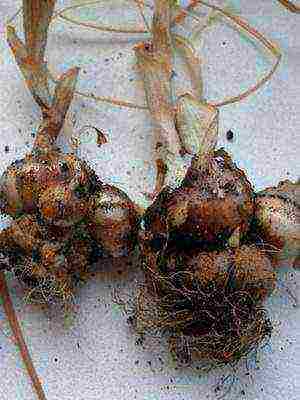

The dug out corms are dried in the shade for several days, then they are cleaned of soil, roots, leaves and old mother bulbs. Drying is continued in a ventilated room at a temperature of 18-20 ° C. 1-2 weeks before planting, the temperature is reduced to 10 ° C.
Crocuses reproduce not only by corms, but also by seeds. The vegetative way is the main one. For a year, an adult corm gives 2-3 replacement bulbs and a small baby. For faster reproduction, crocuses are dug up and planted annually or every other year. With a shallow planting, significantly more daughter bulbs are formed. However, in this case, crocuses need increased watering. The seed method of reproduction is used in breeding work and in the cultivation of species crocuses. Seeds are dried for 2-3 weeks and sown on ridges to a depth of not more than 1 cm. Seedlings bloom in the third or fourth year.
Caring for crocus flowers is not difficult, since these plants are practically not affected by diseases. They can be grown on an alpine slide, under trees and shrubs, in flower beds and in curbs, in containers and garden compositions, on lawns. Most crocus varieties are suitable for forcing during the winter.
Below are photos of planting and caring for crocuses at their summer cottage:

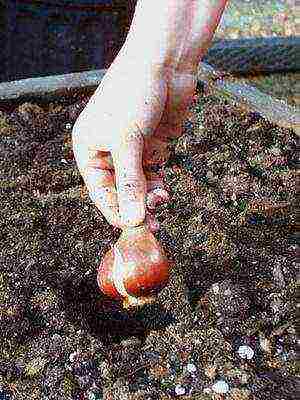
What are crocuses: description of groups and varieties
Currently, there are about 300 varieties of garden crocuses. The whole variety of varieties and species is divided into 15 groups. This takes into account the timing of flowering, as well as the structural features of the bulb.The classification includes crocuses of autumn flowering (group 1), which are not shown here, and crocuses of spring flowering (groups 2-15).
Below is a description of what spring flowering crocuses are and what they look like.
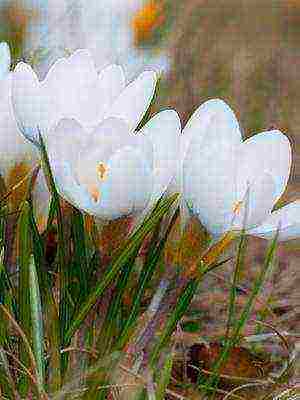

Group 2. Biflorus grows in the south and southwest of Europe, it is found in the Caucasus and Asia Minor. The flowers are purple, the stigma is yellow. There are several natural varieties with flowers ranging from white to lilac.
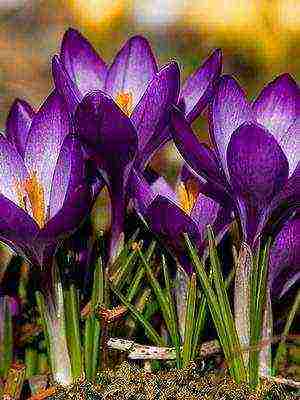
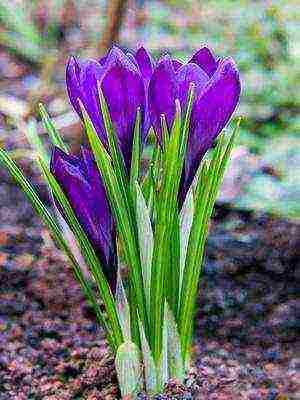
A very interesting variety of crocuses "Alexander" - purple flowers with a narrow white edging, white inside. One bulb forms up to 15 flowers.
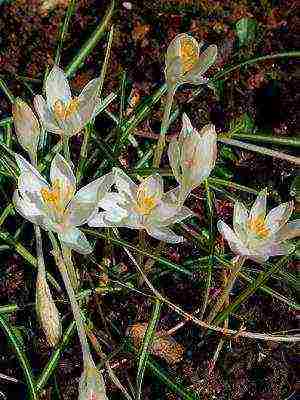
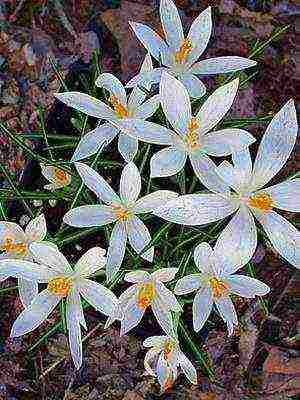
"Albus Biflorus Veldenii" has narrow pure white flowers of small size.
Now look at the photo and read the description of the Chrysanthus crocuses.
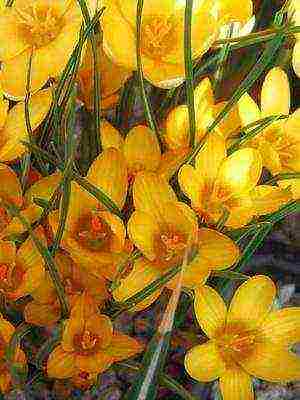
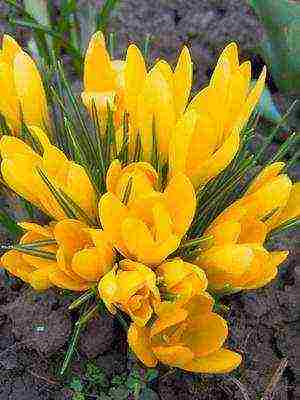
Group 3. Chrysanthus (golden-flowered) grows in southeastern Europe and Asia Minor. The flowers are golden yellow with dark stripes on the outer side of the petals, the stigma is orange-red. The leaves are very narrow. This group includes a fairly large number of varieties. Early, abundant and long flowering is characteristic. A large bulb forms up to 20 flowers.
The most famous are the following varieties:

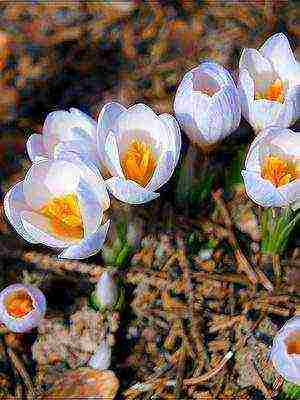
"Blue Pearl" - pearly bluish, almost white when blooming.
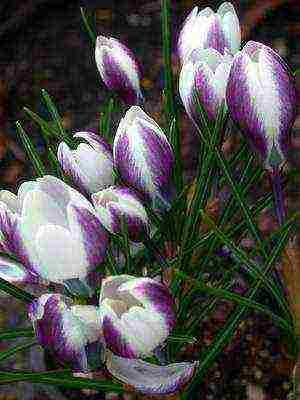
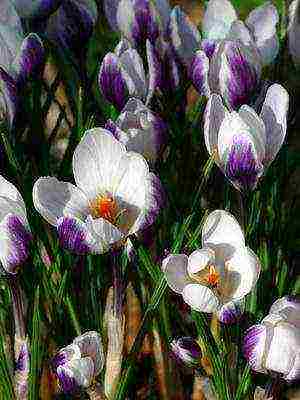
"Lady Keeler" - purple-violet with a white edge, lilac-white inside, shiny.
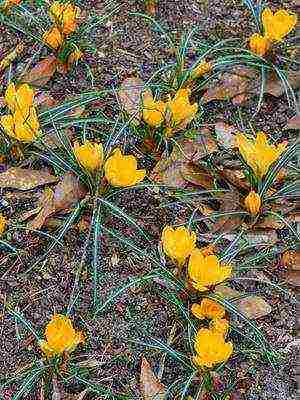
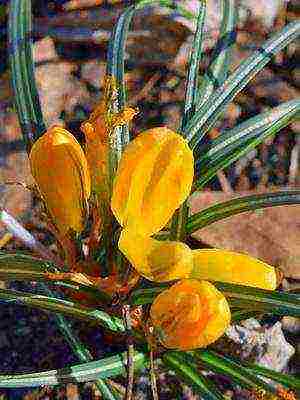
"Marietta" - flowers inside are light yellow, outside petals are lemon yellow with chestnut stripes and strokes.
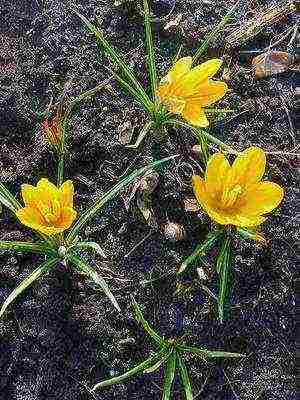
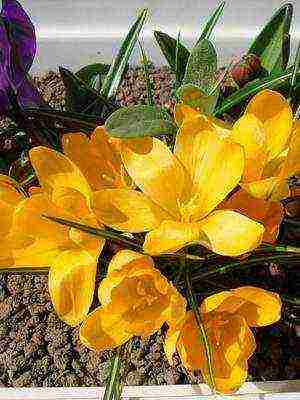
"Nanette" - large flowers are solid yellow inside, canary yellow outside with purple strokes.
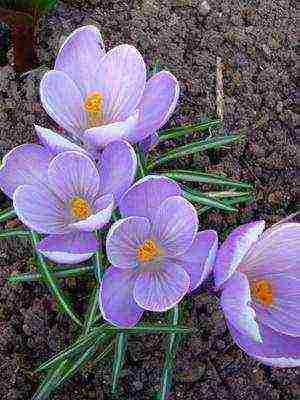
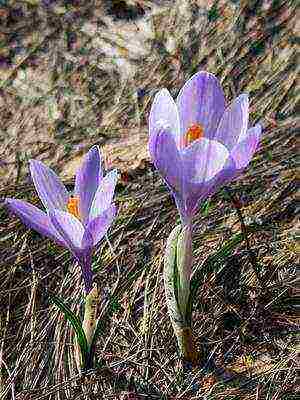
Princess Beatrice - flowers are lilac-bluish with a golden-yellow base.
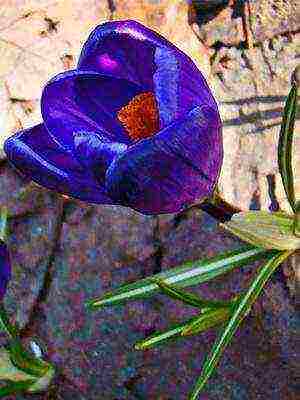
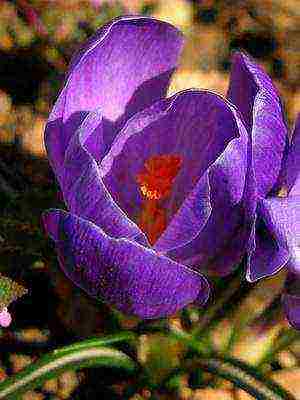
"Schwanenburg Bronze" - Pomegranate brown outside with a narrow yellow border, inside saffron yellow.

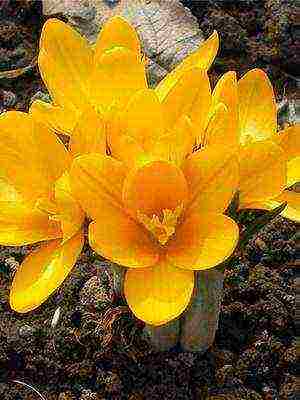
“E.A. Bowls " - lemon yellow, bronze-green base with purple strokes along the edge.

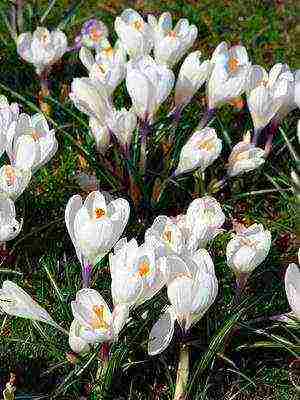
Group 4. Vernus (spring). The varieties of this group occupy a leading place in floriculture, since they are the most unpretentious and resistant to diseases. Most varieties have large flowers of all shades of blue-violet tones, as well as white and variegated colors. Blooming in April. More than 90 varieties have been registered.
The following varieties are most popular.
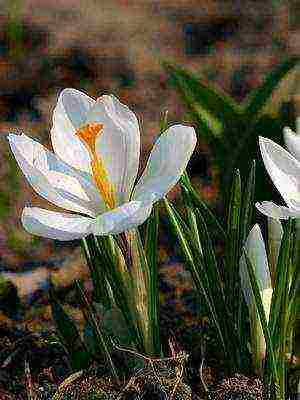

"Albion" - white, purple stripes at the base.

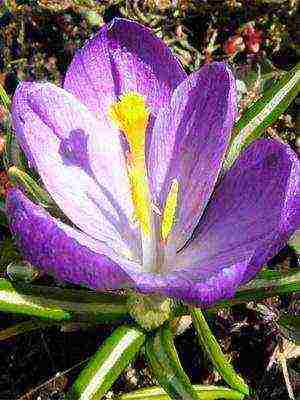
"Baron von Brunov" - purple outside, lighter inside.

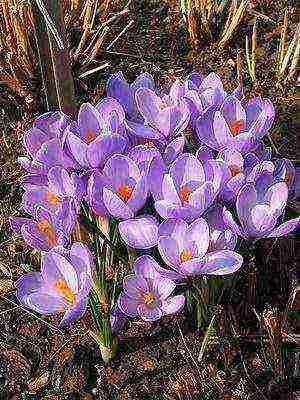
Harlem Jam - flowers are small pink-lilac-gray color, inside amethyst-purple.
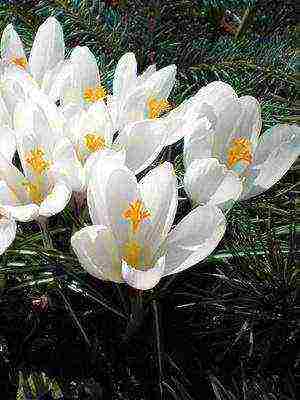

"Joan of Arc" - white with a dark purple base.
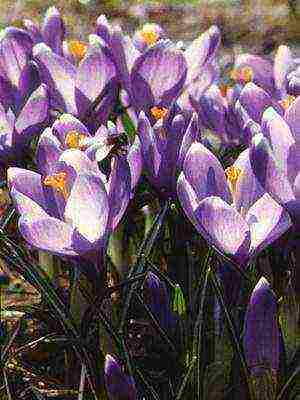
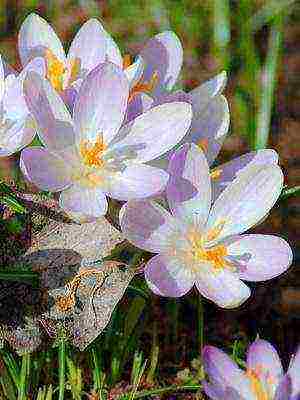
"Inchantress" - light amethyst purple with a silvery sheen.

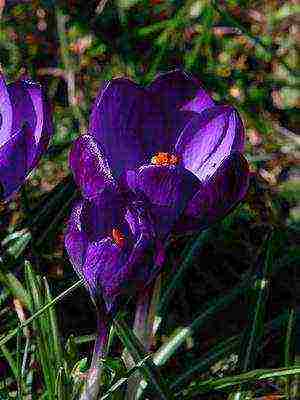
"Negro Boy" - deep purple with a purple base.


"Paulus Potter" - large flowers of dense magenta-magenta color.

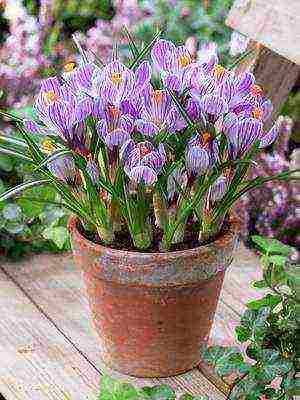
"Pickwick" - The flowers are grayish-white with purple stripes.
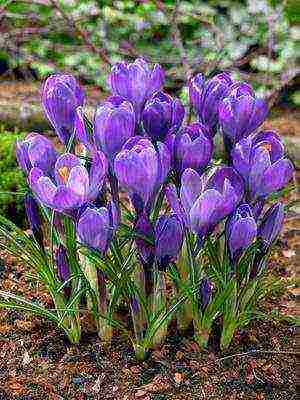
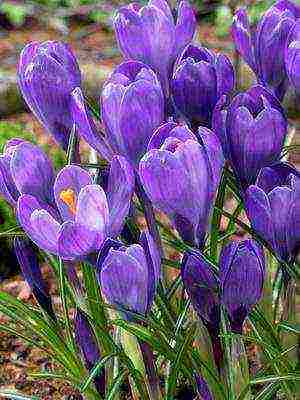
"Remembrans" - purple with a silvery sheen. According to the description of the plant crocus of this variety is most similar to the variety "Baron von Brunov".
Pay attention to the photo of these varieties of crocuses - they are all truly magnificent:
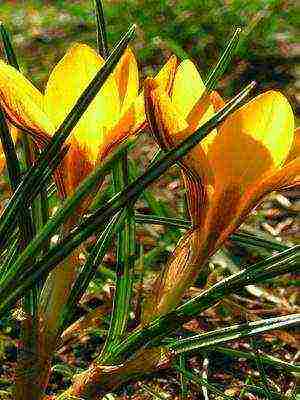
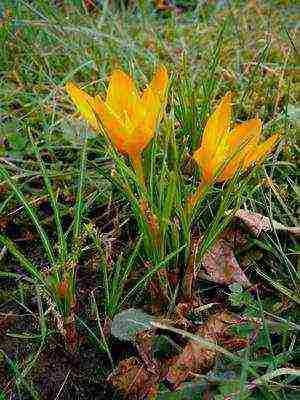
Group 5. Aureus (gold) is found in the Balkans and Asia Minor. The flowers are bright orange. Sometimes outside, at the base of the petals, there are grayish-purple stripes. The stigma is yellow-orange. Blooms in mid-spring. The best yellow crocus is the Grosse Gelbe variety with intense yellow flowers.

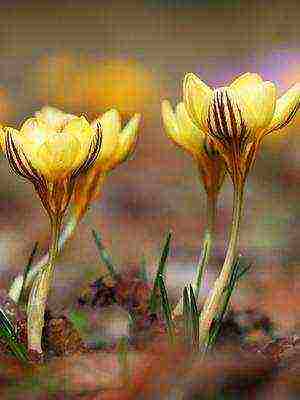
Group 6. Balance is found in the west of Asia Minor. The flower is chrome yellow on the inside, with purple beetroot stripes on the outside. It blooms in early spring.


Includes only one variety: Zvanenburg (van Tubergen) - outside is an orange-bronze color with purple stains, inside is golden yellow.


Group 7. Candidus. This group is represented by only one variety: "Zubflavus" - amber yellow with a bronze tint.


Group 8. Etruscus grows in Italy in the Tuscany region. The flower is bluish purple. There is one variety in the group: Zvanenburg (van Tubergen) - light purple, with a grayish tint on the outside.
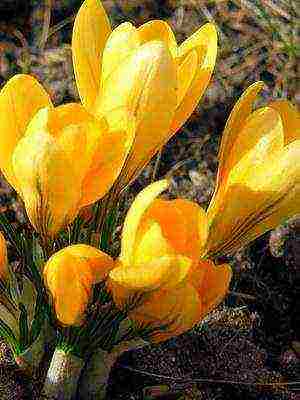
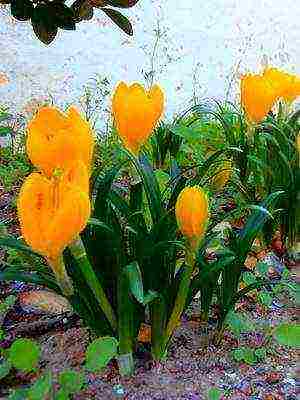
Group 9. Flavus (yellow). This group is made up of Dutch yellow crocuses.The flowers are buttercup yellow, the outside is duller in color, with grayish-green stripes at the base. Early flowering. There are two varieties known: "Confidential" and "Doctor Lotsi".


Group 10. Imperati. Homeland - Southern Italy. Has many natural variations. There is one known variety: "De Jager" - the outer side of the outer petals is amber-yellow with narrow dark purple strokes, the inner petals are violet-blue with three short purple strokes. Inside, the flower is lavender with a yellow center.

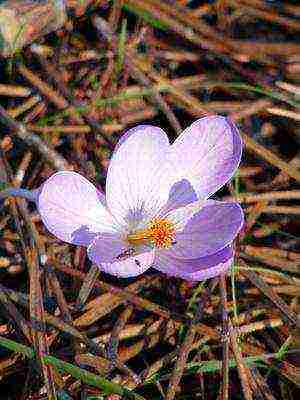
Group 11. Ziberi. Crocus ziberi is considered one of the most beautiful crocuses, it grows in Greece and on the island of Crete. Violet blue with golden yellow throat. The group includes five varieties.
Florists are highly regarded.
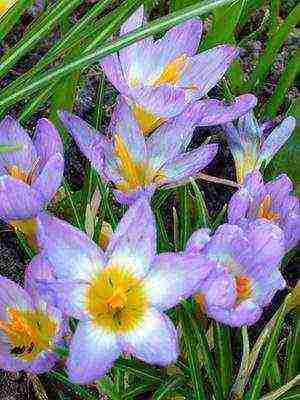
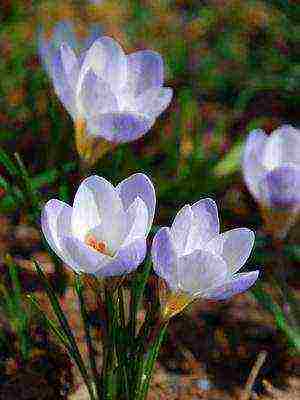
"Hubert Edelsten" - light lilac strokes are harmoniously combined with a purple background, inside the flower is silvery-lilac with a yellow center.


Violet Queen (Hageman) - amethyst violet outside, lighter inside. The base is dull yellow with greenish veins.

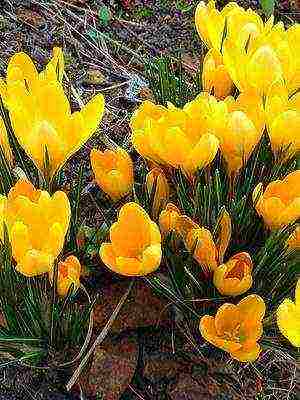
Group 12. Susianus, or Clos of Gold (Golden Brocade) is found in nature from Turkey to the Crimea. The flower is purple on the outside, yellow on the inside. There is a variety of deep yellow color.
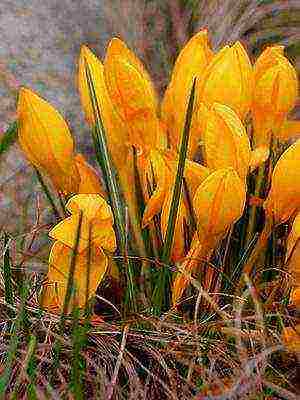
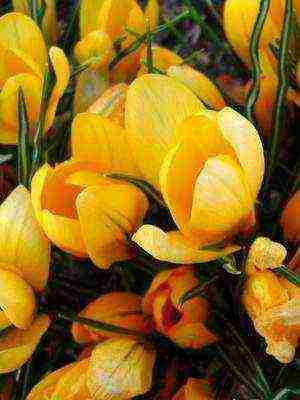
Group 13. Suterianus comes from the central regions of Asia Minor. The flowers are dense yellow. One variety is described - "Jami".
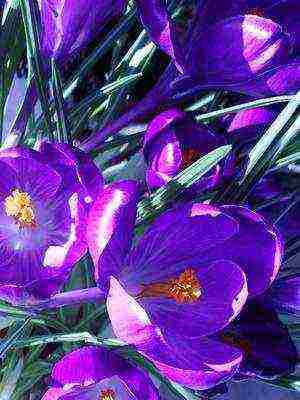

Group 14. Thomasinianus is found in the Balkans. The flower is cobalt purple inside, silvery gray outside. The flowers have high perianth tubes and rise high above the ground. Abundant flowering.
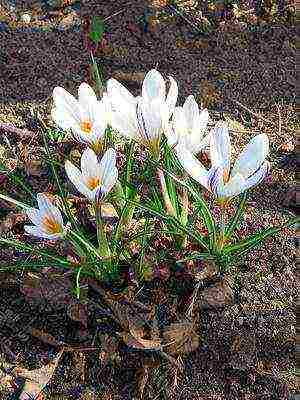
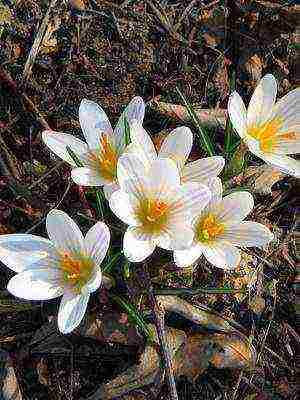
Group 15. Versicolor. Crocus versicolor is found in the Alps and on the French Riviera. The flower is white with purple strokes. Known variety "Clos of Silver" (Silver brocade).

